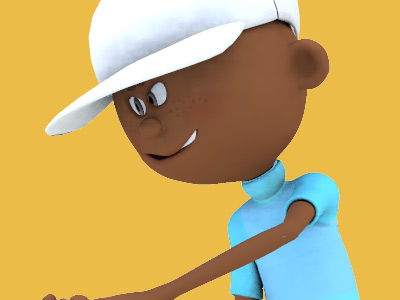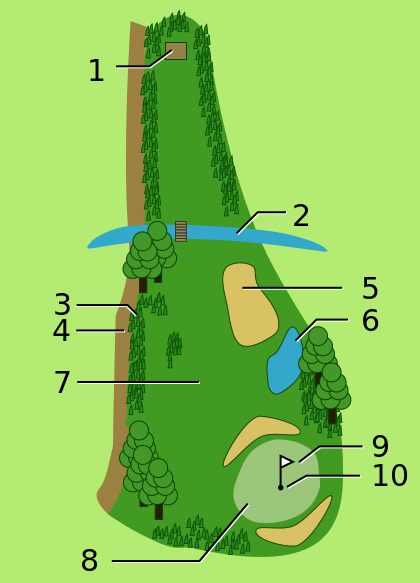Golf

Handicap Systems
A handicap is a numerical measure of an amateur golfer's ability to play golf over the course of 18 holes. A player's handicap generally represents the number of strokes above par that the player will make over the course of an above-average round of golf. The better the player the lower their handicap is. Someone with a handicap of 0 or less is often called a scratch golfer, and would typically score or beat the course par on a round of play (depending on course difficulty).
Calculating a handicap is often complicated, the general reason being that golf courses are not uniformly challenging from course to course or between skill levels. A player scoring even par on Course A might average four over par on course B, while a player averaging 20 over par on course A might average only 16 over on course B. So, to the "scratch golfer", Course B is more difficult, but to the "bogey golfer", Course A is more difficult. The reasons for this are inherent in the types of challenges presented by the same course to both golfers. Distance is often a problem for amateur "bogey" golfers with slower swing speeds, who get less distance with each club, and so typically require more shots to get to the green, raising their score compared to a scratch golfer with a stronger swing. However, courses are often designed with hazard placement to mitigate this advantage, forcing the scratch player to "lay up" to avoid bunkers or water, while the bogey golfer is more or less unaffected as the hazard lies out of their range. Finally, terrain features and fairway maintenance can affect golfers of all skill levels; narrowing the fairway by adding obstacles or widening the rough on each side will typically increase the percentage of shots made from disadvantageous lies, increasing the challenge for all players.
By USGA rules, handicap calculation first requires calculating a "Handicap Differential" for each round of play the player has completed by strict rules. That in itself is a function of the player's "gross adjusted score" (adjustments can be made to mitigate various deviations either from strict rules or from a player's normal capabilities, for handicap purposes only) and two course-specific difficulty ratings: the Course Rating, a calculated expected score for a hypothetical "scratch golfer": and the Slope Rating, a number based on how much worse a hypothetical 20-handicap "bogey golfer" would score compared to the "scratch golfer". The average Slope Rating of all USGA-rated courses as of 2012 is 113, which also factors into the Differential computation.
The most recent Differentials are logged, up to 20 of them, and then the best of these (the number used depends on the number available) are selected, averaged, multiplied by .96 (an "excellence factor" that reduces the handicap of higher-scoring players, encouraging them to play better and thus lower their handicap), and truncated to the tenths place to produce the "Handicap Index". Additional calculations can be used to place higher significance on a player's recent tournament scores. A player's Handicap Index is then multiplied by the Slope Rating of the course to be played, divided by the average Slope Rating of 113, then rounded to the nearest integer to produce the player's Course Handicap.
Once calculated, the Course Handicap is applied in stroke play by simply reducing the player's gross score by the handicap, to produce a net score. So, a gross score of 96 with a handicap of 22 would produce a net score of 74. In match play, the lower handicap is subtracted from the higher handicap, and the resulting handicap strokes are awarded to the higher handicapper by distributing them among the holes according to each hole's difficulty; holes are ranked on the scorecard from 1 to 18 (or however many holes are available), and one stroke is applied to each hole from the most difficult to the least difficult. So, if one player has a 9 handicap and another has a 25 handicap, the 25-handicap player receives one handicap stroke on each of the most difficult 16 holes (25-9). If the 25-handicapper were playing against a "scratch golfer" (zero handicap), all 25 strokes would be distributed, first by applying one stroke to each hole, then applying the remaining strokes, one each, to the most difficult 7 holes; so, the handicap player would subtract 2 strokes from each of the most difficult 7 holes, and 1 each from the remaining 11.
Handicap systems have potential for abuse by players who may intentionally play badly to increase their handicap ("throwing their 'cap") before playing to their potential at an important event with a valuable prize. For this reason, professional golf associations do not use them, but they can be calculated and used along with other criteria to determine the relative strengths of various professional players. Touring professionals, being the best of the best, often have negative handicaps; they can be expected, on average, to score lower than the Course Rating on any course.
SPORTS

RESOURCES
This article uses material from the Wikipedia articles "Golf" and "Golf stroke mechanics", which is released under the Creative Commons Attribution-Share-Alike License 3.0.
© Stories Preschool. All Rights Reserved.









